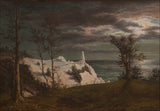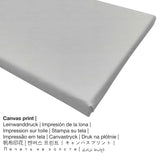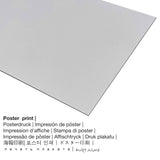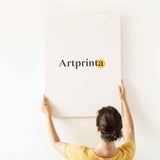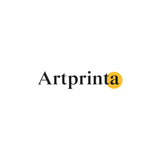Frederik Sødring, 1831 - Oge okpomọkụ Spireon the Chalk Cliffs nke Island Møn. - ọmarịcha nka
Ụtụ gụnyere. Mbupu gbakọrọ na ndenye ọpụpụ.
Nkọwa ihe osise izizi sitere na webụsaịtị ihe ngosi nka (© nwebiisinka - nke Statens Museum for Kunst (National Gallery of Denmark) - Statens Museum maka Kunst (National Gallery nke Denmark))
Sødring was among the few Danish artists of this period to look to Romantic landscape painting for inspiration, and this painting is radically different from the majority of paintings created in Denmark around 1830. Frederik Sødring’s painting of the Summer Spire on the Cliffs of Møn differs greatly from the general feel of most paintings created in Denmark around 1830, first and foremost because it is a nocturnal scene, but also because of the way in which the motif has been treated. The artist has chosen to view the Summer Spire against a dramatic night sky where the moon breaks through the clouds and makes the chalk cliffs appear luminously white against the dark surroundings.
Sødring was among the very small number of Danish artists who looked towards the Dresden school of Romantic landscape painting from the very outset. The art of J. C. Dahl was particularly important to him; for his debut at Charlottenborg in 1828 Sødring presented two copies after Dahl, and in the years that followed the Norwegian painter’s views on art and artistic principles came to be of crucial importance to Sødring’s own work. However, some of his paintings show that he must also, at an early stage, have become interested in the German landscape painter Caspar David Friedrich’s work and artistic devices. Several features of the Summer Spire scene are very reminiscent of the German artist (the moonlight breaking through the clouds, reflected on the sea; and the tree silhouetted against the sky). However, none of the Friedrich paintings that Sødring is known to have had the opportunity to see before 1831 are obvious role models, so in all likelihood Friedrich’s impact has been mediated through Dahl’s moonlit scenes.
The museum also provides interactive material and videos about this artwork.
Ozi ahaziri na nka
| Aha eserese: | "The 'summer Spireon the Chalk Cliffs of the Island Møn." |
| Nhazi nka: | sere |
| Category: | nkà nke oge a |
| Nhazi oge: | 19th narị afọ |
| Emepụtara na: | 1831 |
| Afọ nka: | ihe dị ka afọ 180 |
| Egosiputara na: | Statens Museum maka Kunst (National Gallery nke Denmark) |
| Ebe ngosi nka: | Copenhagen, Denmark |
| website: | Statens Museum maka Kunst (National Gallery nke Denmark) |
| Ụdị nka nka: | ngalaba ọha |
| Site n'aka: | National Gallery nke Denmark |
Tebụl nyocha nke onye na-ese ihe
| aha: | Frederik Sødring |
| Gender: | nwoke |
| Obodo onye nka: | Danish |
| Ọrụ nke onye na-ese ihe: | onye na-ese ihe |
| Obodo onye nka: | Denmark |
| Otu nka: | omenkà nke oge a |
| Oge ndu: | 53 afọ |
| Afọ ọmụmụ: | 1809 |
| Obodo ọmụmụ: | Aalborg |
| Nwuru: | 1862 |
| Ebe ọnwụ: | Hillerup |
Nkọwa akụkọ ahaziri ahazi
| Nkewa ngwaahịa: | nka nka |
| Usoro mmeputakwa: | mmeputakwa n'ụdị dijitalụ |
| Usoro mmepụta: | Mbipụta UV ozugbo (mbipụta dijitalụ) |
| Production: | arụpụtara na Germany |
| Stockdị ngwaahịa: | mmepụta ihe na-achọ |
| Ojiji ngwaahịa: | mgbidi mgbidi, ihe ndozi ụlọ |
| Ndepụta: | nhazi odida obodo |
| Oke akụkụ: | 1.4: 1 - ( Ogologo: obosara) |
| Mmetụta akụkụ: | ogologo bụ 40% ogologo karịa obosara |
| Nhọrọ ihe dị: | Mbipụta iko acrylic (nke nwere ezigbo mkpuchi iko), mbipụta kanvas, mbipụta ọla (aluminium dibond), mbipụta akwụkwọ mmado (akwụkwọ kwaaji) |
| Nhọrọ nke Canvas Mbipụta (akwa akwa na etiti ihe ndọtị): | 70x50cm - 28x20", 140x100cm - 55x39" |
| Mpempe iko acrylic (nwere ezigbo mkpuchi iko) nha dị iche iche: | 70x50cm - 28x20", 140x100cm - 55x39" |
| Mpempe akwụkwọ mmado (akwụkwọ kwaaji) nha dị iche iche: | 70x50cm - 28x20" |
| Nhọrọ mbipụta aluminom: | 70x50cm - 28x20", 140x100cm - 55x39" |
| Nhazi mbipụta nka: | agunyeghi |
Ngwa ngwaahịa ndị ahịa anyị nwere ike iburu
In the product dropdown menu you can pick your favorite size and material. Thus, we allow you to choose among the following options:
- Mbipụta nke aluminom: An Aluminium Dibond print is a material with a true effect of depth - for a modern impression and non-reflective surface. The colors of the print are luminous in the highest definition, fine details of the print are clear and crisp, and you can notice a matte appearance of the product.
- Mbipụta iko acrylic (nke nwere ezigbo mkpuchi iko): The print on acrylic glass, often named a plexiglass print, makes your favorite original artwork into great décor. Your own replica of the artwork is custom-made with the help of state-of-the-art UV print machines. Our plexiglass with real glass coating protects your custom fine art print against light and heat for many decades.
- Kwaaji: A canvas print is a printed canvas mounted on a wood stretcher. Besides, printed canvas creates a familiar and appealing atmosphere. A canvas of your favorite work of art will provide you with the unique chance of transforming your new fine art print into a large size collection piece as you know from art galleries. A canvas print has the advantage of being relatively low in weight, which means that it is quite simple to hang up the Canvas print without the help of any wall-mounts. A canvas print is suitable for all kinds of walls.
- Poster (akwa akwa akwa): Our poster print is a printed cotton canvas paper with a slightly roughened finish on the surface. Please bear in mind, that depending on the absolute size of the poster print we add a white margin of around 2-6cm round about the print, which facilitates the framing.
Background information on this over 180 year-old painting
The 'summer Spireon the Chalk Cliffs of the Island Møn. was by Frederik Sødring. Today, the work of art is part of the digital art collection of Statens Museum maka Kunst (National Gallery nke Denmark) in Copenhagen, Denmark. Site n'ikike nke: National Gallery nke Denmark (licensed - public domain).Moreover, the artwork has the creditline: . Further, the alignment is odida obodo ma nwee nha onyonyo nke 1.4: 1, nke pụtara na ogologo ya dị 40% ogologo karịa obosara.
Legal disclaimer: We try everything in order to depict our art products as accurate as possible and to display them visually in our shop. Nonetheless, the colors of the printed materials and the imprint might differ marginally from the presentation on your screen. Depending on the settings of your screen and the nature of the surface, color pigments can unfortunately not be printed one hundret percent realistically. Bearing in mind that the fine art prints are processed and printed manually, there might as well be minor variations in the exact position and the size of the motif.
© nwebiisinka, Artprinta.com (Artprinta)

